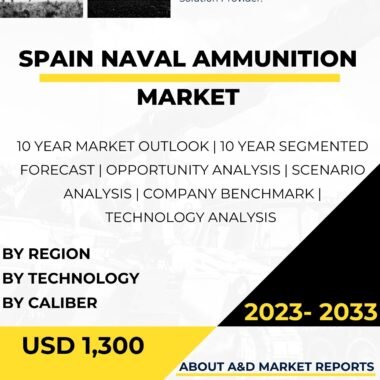Description
The South Korea naval ammunition market is a critical component of the country’s defense industry, providing advanced ammunition and munitions for its naval forces. Naval ammunition plays a crucial role in ensuring the operational capabilities and effectiveness of South Korea’s naval fleet, enabling it to defend its territorial waters, secure maritime interests, and support joint military operations. South Korea’s focus on indigenous development, strategic partnerships, and technological innovation has positioned it as a significant player in the global naval ammunition market.
Naval ammunition encompasses a wide range of munitions used by naval vessels, including surface ships, submarines, and maritime aircraft. These munitions are designed to engage a variety of targets, such as enemy vessels, aircraft, coastal defenses, and land-based targets, effectively extending the naval force’s operational reach and lethality.
Indigenous development has been a cornerstone of South Korea’s defense strategy, and the naval ammunition market is no exception. The country’s defense industry, represented by companies such as Hanwha Corporation and LIG Nex1, has made significant progress in developing advanced naval ammunition tailored to meet the specific requirements of the South Korean Navy.
One of the key indigenous naval ammunition systems in South Korea’s inventory is the “Hae Seong” series of anti-ship missiles. These missiles are designed to engage and destroy enemy vessels at sea, providing South Korea’s naval fleet with a potent capability to deter and respond to maritime threats. The Hae Seong series includes various missile variants, such as the Hae Seong I and II, capable of targeting different types of vessels and operating in diverse naval environments.
Beyond domestic requirements, South Korea actively seeks strategic partnerships with international defense and technology companies to enhance its naval ammunition capabilities. Collaborations with global manufacturers enable technology transfer, joint research, and the integration of foreign ammunition systems into South Korea’s indigenous naval platforms. These partnerships contribute to the continuous improvement of South Korea’s naval ammunition technology and reinforce its position in the global defense market.
Moreover, South Korea’s commitment to innovation and research and development (R&D) has driven advancements in naval ammunition technology. The country invests in R&D programs to improve the performance, range, accuracy, and lethality of naval munitions. Technological improvements focus on enhancing the targeting and guidance systems of anti-ship and anti-submarine missiles, increasing the warhead effectiveness, and developing more efficient and compact naval gun ammunition.
As part of its broader defense industry, South Korea’s naval ammunition market extends beyond domestic needs. The country actively exports naval ammunition and related technologies to other nations, generating revenue and expanding its influence in the global defense market. Successful exports demonstrate the reliability and performance of South Korean-made naval ammunition solutions, contributing to the growth of its defense industry.
To ensure optimal utilization and proficiency in operating naval ammunition systems, South Korea places significant emphasis on training and skill development for its naval personnel. Training programs focus on familiarizing crews with the operation, maintenance, and effective utilization of naval munitions in various operational scenarios.
Moreover, cybersecurity is a significant consideration in the naval ammunition market, as these systems often incorporate digital components and may be vulnerable to cyber threats. South Korea invests in robust cybersecurity measures to protect its naval assets and ensure the safety and security of naval ammunition operations.
In conclusion, the South Korea naval ammunition market is a critical aspect of the country’s defense capabilities. Indigenous development, strategic partnerships, and innovation have allowed South Korea to create advanced naval ammunition that meets the specific needs of its naval forces. From anti-ship and anti-submarine missiles to naval gun ammunition, these munitions enhance the firepower and lethality of South Korea’s naval fleet. As the defense industry continues to evolve, South Korea’s dedication to advancing its naval ammunition technology will remain essential in safeguarding its maritime interests and maintaining its position as a major player in the global naval ammunition market.




